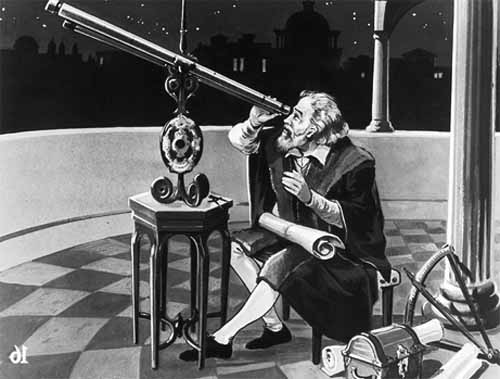
Galileo may not have been perfect in his findings for science but at least he tried. He had heard about a man in Holland who made a small telescope. Galileo was determined to improve this product and began working on several telescopes. He learned how to grind and polish his own lenses and eventually made a telescope that could magnify by eight or nine times. Galileo even made a presentation of this telescope to the Venetian Senate and sold his rights to it to the Senate, which was a fantastic move on his part since he did not invent the telescope originally--it was really a Dutch man. Galileo only improved it (Zax 59).
So, Galileo used his telescope at night and made several discoveries. He wrote these down and published a book called "Starry Messenger" in 1610. He claims that:
The Milky Way is made up of a legion of stars not visible to the naked eye.
The moon has a pockmarked surface and is not a perfect sphere.
Jupiter had four moons, which could answer an objection made against the Copernican theory about how if the Earth moved through space, would it leave behind a moon.
Venus had phases that were similar to the moon and did not move around the Earth but does, in fact, move around the Sun (Johnston "The Galileo Affair").
Galileo was on the verge of coming out publicly and declaring that the theories of Aristotle, who was admired and studied deeply, were refutable. No one had attempted to prove him wrong, and in turn, go against theories that were widely accepted by all. Galileo was not afraid to find from fame; however, he knew that he needed someone powerful on his side so he went after the Medici family. This family had been powerful for many generations. They held elected positions, worked in the banking industry, and had strong connections to the Vatican. Galileo dedicated "Starry Messenger" to the Medici's heir apparent, 16-year old Cosimo II. Galileo even dedicated four stars to Cosimo and called them Cosmian stars; Cosimo wanted the name changed to Medician stars and Galileo was more than happy to make the change (Zax 60).

Galileo had written several documents about his experiments and theories.
The Starry Messenger
The Dialogue on the Two Chief World Systems
The Assayer, which was a response to a document written by Father Orazio Grassi regarding the make-up of comets
Letter to Madame Christina...Concerning the Use of Biblical Quotations in Science, where he argued that the Scripture's purpose is to lead us to God, not explain science.
Letter to Castelli, which concerned the fact that he believed the planets orbited the sun in perfect circles.
Discourse on Floating Bodies
Letters on the Sunspots
Interested in listening to an excerpt of The Dialogue on the Two Chief World Systems?